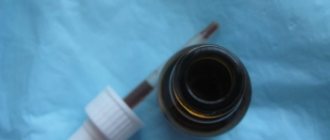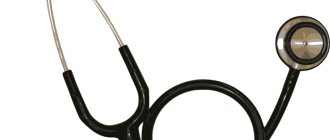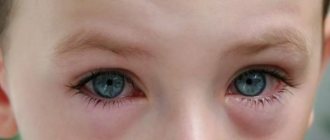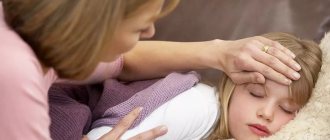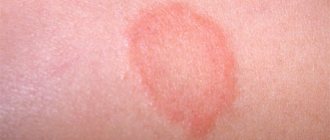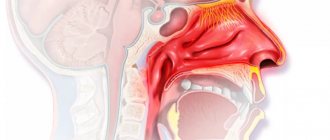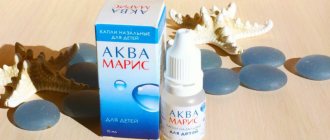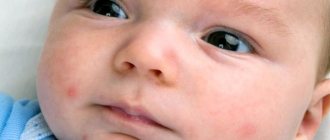Inflammation of the lymph nodes or tonsils brings severe discomfort to the child, as it manifests itself in pain, fever and other unpleasant symptoms. One of the frequently used remedies for such problems is Lymphomyosot. This is a homeopathic medicine from the famous company Heel. Is it prescribed to children and how does the child’s body react to such a drug?
Lymphomyosot is produced in two forms:
- drops that are taken orally. They are represented by a transparent yellow liquid placed in a volume of 30 milliliters in a glass dropper bottle. 1 ml of this product contains 21 drops;
- ampoules with liquid without any odor or color, intended for intramuscular injection. One box contains 5 or 100 ampoules of 1.1 ml each.
The active components of Lymphomyosot (both forms) are the following natural substances:
- The D3 dilution contains ingredients derived from walnut (Juglans regia), nodosa (Scrophularia nodosa) and forget-me-not (Myosotis arvensis), as well as sage (Teucrium scorodonia) and speedwell (Veronica officinalis).
- in dilution D4, the preparation contains substances from winter horsetail (Equisetum hyemale), fumaria officinalis, Robert's geranium (Geranium robertianum), watercress (Nasturtium officinale) and common pine (Pinus sylvestris), as well as Natrium sulfuricum.
- Dilution D5 in the product contains compounds from yellow gentian (Gentiana lutea).
- dilution D6 in drops and solution contains components from the common spider (Araneus diadematus) and smilax (Sarsaparilla).
- dilution D12 in Lymphomyosot contains calcium phosphoricum (Calcium phosphoricum) and iron iodide (Ferrum jodatum), as well as the substance Levothyroxinum.
Additionally, the drops contain ethyl alcohol and water, and the injection form contains sterile water and sodium chloride.
Lymphomyosot has an effect on the lymphatic system.
In particular, the remedy is able to activate the outflow of lymph from various tissues and organs, as a result of which their impaired functions are normalized and the body’s defenses are strengthened.
This action provides anti-inflammatory, anti-exudative, detoxification and immunocorrective effect from the use of drops or injections.
Thanks to Lymphomyosot, the size of enlarged lymph nodes or tonsils is reduced, the child’s immune system more actively fights infectious agents, the source of inflammation is reduced, and toxins leave the body more quickly, which leads to rapid relief from body aches, fever and other symptoms of malaise.
The product is used:
- For lymphatic edema.
- For lymphadenitis.
- For inflammation of the lymphatic vessels.
- For chronic tonsillitis, laryngitis or pharyngitis.
- For swelling that appears as a result of injury or surgery.
- For edema caused by diabetes.
- For edema caused by pathologies of the kidneys or heart.
- For allergic diseases.
- For various intoxications, for example, caused by chemicals, drugs, tuberculosis, physical and other factors.
- For skin rashes caused by intestinal diseases.
- For acquired immunodeficiencies.
- For benign tumors, as well as for malignant neoplasms.
- For sinusitis, runny nose and other chronic diseases of the nasopharynx.
The instructions for Lymphomyosot include information that such a product is not recommended for people under 18 years of age. This limitation is due to insufficient study of the effect of the drug on children and the lack of clinical studies. However, in practice, doctors prescribe Lymphomyosot from birth if there are compelling reasons for taking drops or a course of injections.
Both drops and injections are not prescribed in case of hypersensitivity to any of their ingredients. The presence of thyroid diseases in a child requires increased attention from a doctor when treating with Lymphomyosot. In addition, due to the presence of alcohol drops in the composition, this form is prescribed with caution for brain diseases, traumatic brain injuries and liver pathologies.
Taking drops can cause allergies (urticaria, itchy skin). In such a situation, the drug should be discontinued immediately. In addition, quite often, with the start of using Lymphomyosot, as with the use of other homeopathic remedies, the patient’s condition may worsen for a short time. If such a reaction occurs, it is also advised to stop taking it and consult a doctor.
Drops in the dosage prescribed by the doctor are dissolved in 10 ml of water and given to the child to drink. If possible, the drug should be kept in the mouth for a few seconds. But this will not work with small children, so they can drip the product directly under the tongue without spreading it.
The number of drops is determined by the age of the small patient:
- For babies in their first year of life, 1-2 drops are usually enough per dose.
- For a child 1-3 years old, the drug is prescribed 3 drops.
- Children from 3 to 6 years old (for example, 4 years old) are given 5 drops per dose.
- For a child 6-12 years old, a single dose of the drug is 7 drops.
- A teenager 12 years of age or older is given 10 drops.
Often, in such doses, Lymphomyosot is taken three times a day. The product is given to children either 20 minutes before meals or an hour after meals. The duration of treatment is determined individually, as it depends on the nature of the disease and its course. In this case, most often the drops are prescribed in a course of 2 to 5 weeks.
As for injections, Lymphomyosot is prescribed to children less often in this form than in drops. The single dose, frequency of administration and duration of use for a particular child must be determined by the doctor, since these parameters depend on both the disease itself and the age of the patient.
Cases of negative effects of an excessive dose of Lymphomyosot have not been mentioned until this time. The danger of such a drug in drops in a large dose is associated only with the high concentration of ethanol in its composition, therefore, in case of an overdose, you should immediately consult a doctor.
The annotation accompanying Lymphomyosot notes that such a remedy is compatible with various medications. It can be used together with other homeopathy, as well as with antibiotics, immunomodulators and other medications.
Lymphomyosot drops are sold in pharmacies without a prescription and cost an average of 470-530 rubles per bottle. To purchase the injectable form, you must obtain a prescription from your doctor. The average price of 5 ampoules is 400 rubles.
It is recommended to store Lymphomyosot at home at room temperature where the product cannot be reached by a small child. The shelf life of both forms is 5 years. If it has expired, it is prohibited to give the drug to a child.
You can find mostly good reviews about the use of Lymphomyosot in children. Mothers like this homeopathic remedy for its natural composition, convenient dosage form (easy to measure the dose in drops and swallow for the child) and effective action.
According to many parents, the drug helped the child well with adenoids, swelling or enlarged lymph nodes. However, there are also negative reviews in which mothers complain about the lack of any effect from taking the drops. Also, many parents attribute its high price to the disadvantages of the product.
There are no other drugs on the pharmaceutical market yet that have the same composition as Lymphomyosot. For this reason, you can replace drops or injections with other medications only after consulting your doctor. For example, for chronic tonsillitis, a child may be prescribed Yox, Miramistin, Imudon, Tonsilgon N, Tantum Verde and other drugs.
Among homeopathic medicines, instead of Lymphomyosot for adenoid hypertrophy, sore throat or chronic inflammation of the tonsils, the following are used:
- Angin-Hel SD tablets. They are recommended for use by children over 12 years of age.
- Barberry granules comp. They are dissolved under the tongue until completely dissolved. The drug is used in children over three years of age.
- Tonsilotren tablets. This resorption drug is used from the age of three.
"Lymphomyosot" for adenoids
We immediately need to draw the attention of the readership to this homeopathic remedy, around which serious controversy is flaring up. Especially when the therapeutic aspect is considered - “ Lymphomyosot” for adenoids in children . Among the consumer category from parents who have already used the product in treating their sick children. So it is in the community of pediatric otolaryngology professionals.
Therefore, we advise mothers and fathers who closely monitor the treatment of adenoid pathogenesis in their children to draw the right conclusions. Do not rush, categorically, deny or zealously take the side of defense of homotoxic* “Lymphomyosot”.
We consider the following option to be the most successful format for covering this topic. The title of each section includes a query (question), which is most often entered into the search of social networks (regarding “Lymphomyosot”). The answer to it constitutes the informational context of the section.
It will include reviews as adherents of “Lymphomyosot” when affecting pathogenic adenoids in children. So are the opponents of the use of this: a trigger-catalyst for the elimination* of a pathogenic mass, a creator of diffuse* (transepidermal*) conductivity for other intensively acting nasal medications, the subject of debate - “Lymphomyosot”. At the end of the section, a dictionary is presented to decipher and explain complex medical terms in the text (marked with *).
Reception features
How to take Lymphomyosot for adenoids in children? The first and main condition: use only as prescribed by a doctor. There is a misconception: if the medicine is of plant origin, you can safely give it to your child without a doctor’s prescription. Monitoring by a pediatrician or otolaryngologist when taking this drug is required. It is also necessary to carefully read the instructions before taking Lymphomyosot. What is important to pay attention to?
- Dosage. Pediatric doses are indicated in the instructions for the drug. Newborns and children under 2 years old - 2-3 drops 2-3 times a day, children from 2 to 6 years old - 7-8 drops 2-3 times a day. After 6 years, the child is prescribed an adult dose of the medicine - up to 10 drops 2-3 times a day. The doctor's prescription may indicate other numbers. This depends on the child’s weight, the severity of the disease, and the doctor’s individual experience. If the prescribed dose significantly exceeds the daily norm, you can always ask your doctor about the reason for this prescription.
- How to drink? Sublingual administration, that is, under the tongue, is recommended. It is necessary to draw the child's attention so that he holds the drops in his mouth for some time. It is allowed to dilute the drops in a small amount of water. You can also dilute the daily dose of drops in a glass of water, divide into portions and drink throughout the day. Drops are taken (strictly!) 30 minutes before meals or an hour after meals. If this important condition is not taken into account or violated, the effectiveness of the homeopathic remedy can be reduced to zero.
- Well. The doctor individually determines the duration of treatment. The course of therapy can range from 2 weeks to 3 months and depends on the severity of adenoiditis and the individual characteristics of the body.
Possible side effects and reactions
The instructions for use of Lymphomyozot indicate that no side effects or contraindications have been identified. However, there are a few important points to pay attention to.
- Worsening of symptoms. This does not happen to all patients. The doctor should warn you about this. One of the properties of homeopathy treatment is a temporary exacerbation of the disease. Therefore, a runny nose, snoring, and difficulty breathing through the nose may increase at the beginning of the course of treatment.
- Allergic reaction. There are cases of moderate and acute allergic reactions to taking this medication. It can be triggered by any of the components of the drug.
- Increased activity of the thyroid gland. Iodized iron and levothyroxine are substances that can activate the thyroid gland. If a child has problems with the thyroid gland, be sure to consult an endocrinologist before taking the drug.
Any suspicious reactions or deterioration of the child’s condition after starting to take Lymphomyosot should be under the supervision of a doctor. In case of acute allergic reactions, the doctor may stop taking the medication or reduce the dosage. If it is not possible to urgently contact your doctor, but there is a suspicion that it is Lymphomyosot that is causing the reaction, it is recommended to temporarily stop taking it until you consult a doctor.
Question: “Lymphomyosot” for adenoids in the nose in children
Feedback: conflicting reviews from parents
Indeed, if you go to sites that specialize in medical topics, the treatment of adenoids in children, in the comments and forums you can read radically opposite reviews about Lymphomyosot.
Some mothers respond with gratitude and describe the successful use of Lymphomyosot in curing an adenoid problem in their child. They mention that the product is stable and exhibits intense healing properties. They note a positive emphasis - “Lymphomyosot” is exclusively a homeopathic remedy. It contains practically no synthetic pharmacological chemistry.
In contrast to the laudatory texts in the comments, in almost equal proportions, you can learn about “what an unfavorable natural medicine this is” from another category of parents. How disappointed they were after the course of treatment. They regret that the otolaryngologist, in general, prescribed Lymphomyosot for adenoids in their children. Moreover, he explained in detail how to take it correctly (hours of administration, dosage). But the child did not show anything good, any encouraging effect that the parents were counting on.
Professional analysis and opinion of pediatric ENT/Otolaryngologists about “Lymphomyosot”
Narrow-profile experts in the field of pediatric oto/conservative therapy do not base their opinion on emotional perception – “like it or not.” And it is right. Representatives of science and medicine (pediatrics, ENT), who devoted their lives to the noblest goal - the treatment of sick children, know and are responsible for every word of their competent conclusion.
IT IS IMPORTANT! First of all, they consider Lymphomyosot a necessary treatment for children diagnosed with adenoid vegetation. They emphasize that there is nothing harmful or dangerous for the child’s body in its composition, in the manifestation of pharmacokinetic characteristics, for the functionality of biochemical processes, or visceral vital organs. This is the main thing, this is, a priori, and this is the most evidentiary factor for everyone!
Second accent. “Lymphomyosot” is an intense trigger (start button) in launching an amazing therapeutic effect, the process of eliminating* pathogenic toxins. Practicing ENT doctors can talk for hours and with delight about the importance of “Lymphomyosot” as a universal catalyst in creating diffuse permeability in (transepidermal healing invasion) into pathogenic adenoid locations.
As a result, the natural lymphatic drainage reflux syndrome* is dynamized. With its dynamization, the reduction of leukocyte phagocyte cells comes into a balanced state. Extremely accumulated lymph fluid is drained from the intercellular matrix (lymph drainage) without delay, thereby allowing Lymphomyosot to exhibit stable healing properties:
- Anti-inflammatory characteristics;
- Antiseptic;
- Immunomodulatory and stimulating protective functionality;
- Dezintoksikacionnye;
- Antiexudative.
For example, “Lymphomyosot ” , prescribed as drops for adenoids , invisibly, but especially effectively normalizes diffuse homogeneity* in the membrane-cellular nasal epidermis. Thanks to this excellent manifestation, the interconnection of the most important organic systems (neuro/immuno/endocrine) is stimulated. Without which, rehabilitation synthesis and metabolism at the gene-cellular level in the nasopharyngeal mucosal epithelium affected by adenoid pathogenesis is impossible.
Question: “Lymphomyosot” for adenoids: how to take?
Answer: We won’t repeat ourselves.
Having read the text material covering detailed, step-by-step instructions for use and use of children's intranasal medications (synthetic or homeopathic), believe me, parents will not be able to cure pathological adenoids in their child’s nose!
Because, without seeing with your own eyes at what stage, the biological state of adenoid pathogenesis, the adenoids are located, specifically of any baby, it is beyond frivolous to treat, to perform therapeutic actions.
In conclusion, the best advice and recommendation is to address the question directly: “ How to take Lymphomyosot for adenoids? ", to the attending ENT doctor. If for some reason you are not satisfied with the consultation you received, contact the clinical consultation centers for ENT diseases and pediatric otolaryngology.
Dictionary of medical terms:
- (homotoxic*), homotoxicity is pseudo toxicity, an artificially created intoxication effect (like vaccination, strains disinfected with toxins). “Lymphomyosot” causes profuse nasal discharge and sweating in order to remove pathogenic microflora from the body with such artificial “painful” symptoms and prevent the penetration of toxins into the bloodstream;
- (diffuse*transepidermal*) – diffusion (penetration at the micron, cellular level of biosubstances). Transportation of medicinal components to the external and internal layers of the organ;
- (elimination process*), elimination is the reaction of removing foreign, foreign, infectious agents-harmful substances, putrefactive decay products from the body;
- (homogeneity*) – uniform density of the epidermis of the lymphoid gland;
- (natural lymphatic drainage reflux syndrome*) is a physiological, congenital process that indicates a contraction of lymph vessels that release (drainage, this is a drainage) pathogenic toxins;
- (case history*) – description of signs and symptoms during the course of adenoid pathogenesis, entering them into the history of a child’s illness;
- (ascites) – swelling of the epidermis, retention of intercellular fluid in body tissues;
- (intercellular matrix*) matrix is an intracellular space filled with bioreproductive fluid (cell water).
Source
Lymphomyosot: instructions for use for children with adenoids, how to take
Rating: No rating
Adenoiditis in children is a fairly common disease, which is accompanied by such main symptoms as impaired nasal breathing and hearing. If not cured in time, it provokes further frequent inflammatory processes in the nasopharynx (pharyngitis, bronchitis, tracheitis, pneumonia) and acute respiratory infections. At the first signs of the disease, it is necessary to urgently begin treatment. Thus, complex treatment therapy for childhood adenoiditis often includes Lymphomyosot, a homeopathic drug from the German pharmaceutical manufacturer Heel. It promotes the outflow of lymphatic fluid from organs, as well as increasing the protective functions of the lymph nodes.
Composition and release form
The drug Lymphomyosot, produced by the famous German corporation Heel, is available in two dosage forms:
- drops placed in a bottle with a 30 ml dropper dispenser;
- solution for intramuscular administration, placed in ampoules of 1.1 ml each.
In pediatrics, this drug is used mainly in the form of drops. It includes a fairly large number of active components: field forget-me-not, speedwell, dubrovik, common pine, yellow gentian, horsetail, knotweed, walnut, cross spider extract, medicinal sarsaparilla, fumaria officinalis, geranium, nasturtium, calcium hydrogen phosphate , Glauber's salt, iron iodide, levothyroxine. Additional components are:
- for drops: 96% ethanol, purified water;
- for solution: sodium chloride, water for injection.
How the drug works
Homeopathic drops Lymphomyosot are medications that stimulate the lymphatic system. During inflammation, toxins and breakdown products, viruses, and bacteria accumulate in the nodes. This disrupts the functioning of internal organs, blocks the transmission of nerve impulses, and contributes to the spread of infection.
Read more Instructions for using Hypromelose-P eye drops
The drug has the following properties:
- activates the outflow of excess fluid from soft tissues;
- cleanses lymph nodes;
- stimulates metabolism;
- increases immunity.
Drops remove toxins, helping the body fight infection. It does not destroy pathogenic bacteria and viruses, but the lymphatic system begins to independently suppress their growth and reproduction. When using the drug, immunity in the intestines is restored, and the effect of using other drugs (antibiotics, antivirals) appears faster.
Indications for use
Lymphomyosot is good for allergy sufferers
There are two main indications for prescribing the drug - these are the consequences of various negative factors on the body, including toxic and infectious, as well as diseases associated with impaired lymph outflow (lymphadenitis, lymphedema).
As an adjuvant, the drug is used in therapy:
- post-traumatic edema;
- postoperative swelling;
- manifestations of seasonal allergies;
- tonsillogenic intoxication;
- tuberculosis.
The prescription of Lymphomyosot for adenoids in children is practiced after removal of the tonsils, as well as during the treatment of complications caused by the disease. The drug activates the body's defenses, helps fight infection and reduces swelling of the mucous membrane, thanks to which otolaryngologists often complement the treatment of adenoids with Lymphomyosot.
Indications
The drug Lymphomyosot is indicated for:
- lymphatic edema;
- inflammation of the lymph nodes;
- inflammation of the lymphatic vessels;
- swelling resulting from injury or surgery;
- edema caused by diabetes mellitus;
- the presence of benign and malignant formations;
- edema resulting from cardiac and renal pathologies;
- manifestations of allergies;
- tonsillitis, pharyngitis or laryngitis;
- intoxications of various etiologies;
- rashes on the skin due to problems with the intestines;
- acquired immunodeficiencies;
- sinusitis, runny nose and diseases in the nasopharynx.
The medicinal composition of Lymphomyosot
The drug contains 17 medicinal components - plant, animal and mineral.
The main medicinal plants that are used in the production of Lymphomyositis:
- Geranium (pelargonium) is an antiseptic, stops the growth of bacteria and the replication of viruses, relieves pain and discomfort in the throat, and stops bleeding.
- Horsetail – relieves inflammation, removes toxins, improves metabolic processes.
- Gentian yellow is an anti-inflammatory and sedative, relieves cough, normalizes temperature.
- Dymyanka – anesthetizes, tones, relieves swelling.
- Scots pine – disinfects mucous membranes and tissues, cleanses blood and lymph, reduces inflammation, strengthens the body.
- Veronica officinalis is an antimicrobial and anti-allergenic agent, promotes tissue restoration, regulates metabolic processes.
- Nasturtium - relieves cough and expectoration of sputum, kills pathogenic microflora, relieves inflammation of the lymph nodes.
- Norichnik - relieves burning, itching and sore throat, promotes the healing of erosions and ulcers of the mucous membrane.
- Walnut – restores the body’s energy and defenses, provides all the necessary vitamins, amino acids and other biologically active substances.
- Dubrovnik – alleviates the condition of hypertrophy of tissues of various types, supports the body during chronic inflammatory processes.
- Forget-me-not is a mucolytic and anti-inflammatory plant.
- Sarsaparilla – cleanses body fluids.
Comparison of two drugs
It is worth understanding the action of the drugs to understand what is best for adenoids. Both remedies have similarities, but also differ in composition, and therefore in therapeutic effect.
What is the difference
The main difference between herbal preparations is that Sinupret is considered a remedy for the treatment of nasal diseases. Although with inflammation of the adenoids, a runny nose is a concomitant pathology.
"Tonsilgon" is prescribed to reduce inflammation of the throat with tonsillitis, pharyngitis, laryngitis. The drug is actively used in the prevention of complications of viral and bacterial infections.
What properties are similar
Among the common characteristics of the drugs is that they are effective against:
- inflammation;
- swelling of mucous tissue;
- pathogenic microorganisms.
Using drops or pills helps drain secretions from infected tissues.
How do they address the problem?
Despite the different composition, both drugs have a systemic effect on the patient’s body. For those who suffer from chronic inflammation of the throat and nose, it is useful to use drugs to prevent diseases. Plant extracts will help strengthen the immune system during flu and colds.
Mechanism of action
Lymphomyosot for adenoids is prescribed as a general tonic. Properties of homeopathic medicine:
- improves lymph flow,
- reduces swelling of the mucous membrane,
- increases immunity,
- has an anti-inflammatory effect,
- stimulates the process of renewal of inflamed tissues,
- normalizes secretory function,
- has a detoxifying effect,
- activation of the body's defenses,
- normalization of metabolic processes.
The effect of the drug is due to the properties of the components of mineral, plant and animal origin that are part of the homeopathic remedy.
Directions for use and dosage
The drops must be taken orally, dissolved in a small amount of water (10–20 ml). It is recommended to take this drug 20 minutes before meals or 1 hour after. For a better effect, you can hold the water with the drug in your mouth for a few seconds before swallowing. Lymphomyosot must be taken 3 times a day, while the single dosage is:
- for babies under 1 year old – 1 – 2 drops;
- 1 – 3 years – 3 drops;
- 3 – 6 years – 5 drops;
- 6 – 12 years – 7 drops;
- over 12 – 10 drops.
As a rule, treatment lasts 3 – 5 weeks.
The solution can be used for intramuscular, intravenous and subcutaneous injections, and can also be taken orally (in this case, a single dose is dissolved in 50 ml of purified water). As a rule, manipulations with Lymphomyosot solution (in the amount of 1 ampoule) are carried out 1-3 times a week, and in severe cases - daily (but no more than 5 days in a row).
Lymphomyosot for adenoids in children: how to take drops, reviews of treatment
- Endocrinologist of the highest category Anna Valerievna
- 29438
- Update date: May 2020
Homeopathy is often prescribed for children
Such drugs can be easily underestimated and at the same time overestimated, so when choosing a medicine you should rely on the doctor’s experience. Drug-based lymphomyosis in the adenoids is used as an adjuvant in the complex treatment of the disease.
It cannot replace full medical treatment, but it can significantly improve a child's health.
Release form and composition
The most popular dosage form of lymphomyosote is drops, the solution is also found in ampoules
The drug is available in 30 ml opaque glass bottles. 1 ml of solution contains 21 drops. The medicine is a homeopathic multicomponent solution based on
- An unforgettable field;
- Drug Veronica;
- Skorodonia Dubrovnik;
- Scots pine;
- Robert's Geraniums;
- Watercress;
- Walnut;
- Yellow gentian;
- Smilax roots;
- Godson Tiara;
- Horsetail;
- Iron iodide;
- Sodium sulfate;
- Calcium phosphate;
- Levothyroxine.
The amount of herbal components is 5 g; iron iodide and other drugs of this group - 10 g per 100 g of solution. Auxiliary and forming components are water and ethanol. The drug contains 33% ethanol.
Another form of release - ampoules with an injection solution - has recently been rarely found on the market.
The drug is dispensed over the counter. The drug is very popular, so it is available in all pharmacies.
Mechanism of action
Lymphomyosis in the adenoids is prescribed as a general tonic. This homeopathic medicine:
- improves lymphatic drainage;
- reduces swelling of the mucous membrane;
- increases immunity;
- has an anti-inflammatory effect;
- stimulates the process of renewal of inflamed tissues;
- normalizes secretion function;
- has a detoxifying effect;
- activates the body's defenses;
- normalizes metabolic processes.
The action of the drug is based on the properties of the components of mineral, plant and animal origin that make up the homeopathic drug.
Indications for use
Lymphomyosis is good for allergy sufferers
The main indications for the use of the drug are the consequences of various negative factors on the body, including toxic and infectious, as well as diseases associated with impaired lymph flow (lymphadenitis, lymphatic drainage).
The drug is used as an adjuvant in the treatment of:
- post-traumatic edema;
- postoperative swelling;
- manifestations of seasonal allergies;
- tonsil poisoning;
- tuberculosis.
The prescription of adenoid lymphomyositis in children is practiced after removal of tonsils and in the treatment of complications caused by the disease. The drug activates the body's defenses, helps fight infections and reduces swelling of the mucous membrane, which means that ENT specialists often supplement treatment with adenoids for lymphomyosis.
Instructions for use for adenoids in children
How to treat lymphomyositis on the adenoids in children depends on the age and stage of the disease. The appointment schedule and duration of therapy are determined by the ENT doctor individually for each patient. A single dose of lymphomyositis in children with adenoids depends on age:
- up to 1 year - no more than two drops;
- 1-3 years - 3 drops;
- 3-6 years - 5 drops;
- 6-12 years - 7 drops;
- over 12 years old - adult dose 10 drops.
Drink lymphomyositis in the adenoids in children according to the following scheme: dissolve drops in accordance with the child's dose in 10-20 ml of water and take 20 minutes before meals or an hour after the last meal. Food should be taken three times a day.
Recommended doses of the drug Lymphomyositis for children can only be changed by the attending physician.
The duration of treatment depends on the severity of the disease. On average, therapy with a homeopathic remedy lasts 14-28 days.
A break follows, and after two weeks treatment can be resumed if there are signs that therapy can be continued.
Contraindications and side effects
Various reactions such as acne or rashes may occur on the face or body.
The natural drug has only one absolute contraindication - intolerance to the components of the composition. The drug has no age restrictions; drops can also be taken by infants in the first year of life, but only after consultation with a doctor.
For diseases of the thyroid gland, the drug is administered with caution, as it contains iodine. In this case, you should consult your doctor about the advisability of taking a homeopathic medicine. If the thyroid gland is overactive, the medication should be discontinued.
Please note! Treatment with adenoids can be supplemented with lymphomyosot, but this drug does not replace complex drug therapy.
The drug is well tolerated by the body and does not cause side effects. In rare cases, symptoms of hypersensitivity may occur:
- itchy skin;
- skin rash;
- hives;
- redness of the skin.
If such signs are present, you should consult your doctor to change the drug or reduce the dose.
Drug interactions
The homeopathic remedy does not react with other medications; in any case, the official instructions for use do not contain such information. The only precaution that should be taken is not to take iodine-containing drops, as this is potentially harmful to the thyroid gland.
It is recommended to consult a doctor if you have any doubts about the drug's interaction with medications that a person must take for a long period of time.
Analogues and cost
The spray facilitates nasal breathing, which is important for polyps
The drug in drop form costs an average of 550-600 rubles per bottle. Ampoules are cheaper - about 350 rubles for 5 pieces.
Note: The ampoules are strictly prescribed and have age restrictions - they can only be used by patients over 18 years of age. Children with adenoids are prescribed drops.
Lymphomyosis for children with adenoids is most often prescribed, but analogues can be chosen if desired. There are no medicines with exactly the same composition, but a wide range of homeopathy is offered to treat tonsil diseases.
Lymphomyosis can replace the following analogues in children with adenoids.
- Briapis Edas-307, available as syrup, contains bee, wolfsbahn, beauty and echinacea extracts. A drug with a complex effect is used to treat otitis, tonsillitis, adenoids and adenoid complications. It has an immunostimulating effect and is suitable for children over 1 year of age. Cost - 150 rubles. for a bottle of syrup.
- Rinitol Edas-131. homeopathic drops for the treatment of sinusitis. Taking the drug helps relieve swelling of the nasopharynx, improve nasal breathing and prevent the development of sinusitis complicated by adenoids. Nasal drops are prescribed for children over two years of age. Cost - 120 rubles.
- Euphorbium compositum. A nasal spray is prescribed to normalize nasal breathing with adenoids. Suitable for use by children over two years of age. Cost - from 550 rubles.
All of these analogues are available without a prescription. Before use, you should consult your doctor and rule out allergic reactions to the components of the composition.
Is it worth using at the same time?
Inflammation of the adenoids leads to the spread of infection into the nasal cavities. And viral diseases in the sinuses contribute to swelling of the tissues in the throat. But you should not take drugs together. They contain so many herbal products that can cause a severe allergic reaction.
Is it possible to start treatment with one remedy and continue with another?
Tonzilgon is prescribed for 7 days. If the symptoms of the disease do not go away, then it is necessary to reconsider the prescription. It is advisable to switch to pills, which can more effectively affect the symptoms of the disease.
You can switch from Sinupret to Tonzilgon if inflammation of the adenoids occurs as a complication after sinusitis. But the body’s reaction to a new drug is always checked and the form of the drug that is most suitable for a particular patient is selected.
Analogs
Unfortunately, there are no medications on the pharmaceutical market with a composition similar to Lymphomyosot, so replacing it with one or another drug can only be done after consulting a doctor. For example, the following homeopathic remedies are used to treat various pathologies of the ENT organs:
- Angin-Heel S (approved for use from 1 year);
- Tonsilotren (approved for use from 2 years);
- Tsinabsin (approved for use from 2 years);
- Barberry comp (approved for use from 3 years);
- Briapis Edas-307 (approved for use from 1 year);
- Vokara (approved for use from 1 year).
Analogues and cost
The spray facilitates nasal breathing, which is important for adenoids
The drug in drops will cost an average of 550-600 rubles. per bottle. Ampoules are cheaper - about 350 rubles. for 5 pieces.
Note! The ampoules are sold strictly according to a prescription and have age restrictions - they can only be used by patients over 18 years of age. Drops are prescribed for children with adenoids.
Lymphomyosot is most often prescribed for children with adenoids, but analogues can be selected if desired. There are no drugs with exactly the same composition, but a wide selection of homeopathy is offered for the treatment of tonsil diseases.
For adenoids in children, Lymphomyosot can replace the following analogues.
- Briapis Edas-307. Available in syrup form, it contains bee extract, aconite, belladonna and echinacea. A complex action drug used for the treatment of otitis media, tonsillitis, adenoiditis, and complications of adenoids. It has an immunostimulating effect and is suitable for children over 1 year of age. Cost – 150 rubles per bottle of syrup.
- Rinitol Edas-131. Homeopathic drops for the treatment of sinusitis. Taking the drug helps relieve swelling of the nasopharynx, improve nasal breathing and prevents the development of sinusitis, which complicates the adenoids. Drops for instillation into the nose are prescribed for children over two years of age. Cost – 120 rubles.
- Euphorbium Compositum. Nasal spray is prescribed to normalize nasal breathing in case of adenoids. Allowed for use by children over two years of age. Cost – from 550 rubles.
All of the listed analogues are available without a prescription. Before use, you should consult your doctor and rule out an allergic reaction to the components of the composition.
Homeopathic remedy "Tonsilgon"
An analogue of Lymphomyosot, which is often preferred by consumers, is Tonzilgon. This medicine is exactly the same as homeopathic remedies. Available in the form of drops and tablets. The drug costs 450 rubles - solution and 400 rubles. - dragee. We can say that this is a cheap analogue of Lymphomyosot, but the composition of the drugs is different. The basis of the drug "Tonsilgon" was: marshmallow root, chamomile, horsetail, yarrow, walnut, dandelion and oak bark.
Indications for the use of this drug are infectious and inflammatory diseases of the upper respiratory tract: tonsillitis in various forms, pharyngitis, adenoiditis. The medication has a pronounced anti-inflammatory and antiseptic effect, accelerates the regeneration of lymphoid tissue. Children are allowed to take pills only from 6 years of age. Drops have been used since one year.
Reviews
Valeria:
I like that this drug has an incredibly broad effect. Personally, at the suggestion of my local doctor, I used it to treat sore throat, sinusitis, tonsillitis, allergies and mastopathy. And Lymphomyosot always coped with a bang.
Catherine:
At a certain age, every child’s harmless ARVI began to end in inflammation of the lymph nodes: they were very painful and caused him severe discomfort. And this lasted for several months. But once we were advised, after another illness, to take a course of Lymphomyosot to cleanse the lymph. Of course, there was no immediate healing, but our problems with the lymph nodes gradually began to go away. Now they are just a little bit inflamed and go away immediately.
Maria:
She herself was treated with Lymphomyosot for chronic tonsillitis. A wonderful tool! Previously, I almost constantly (and I’m not kidding!) had a sore throat, but after taking this drug I finally stopped suffering.
Antonina:
I first purchased this product for my son. The fact is that after each cold, we treated adenoids, inflamed tonsils and lymph nodes for a long time and tediously, and on the Internet I read many reviews that Lymphomyosot helps with all of the above symptoms, and is absolutely safe for children, since it has a natural compound. And the otolaryngologist advised us to buy it. We drank it, of course, for a long time - about a month (this is the minus of homeopathy), but everything returned to normal, and the next cold did not happen again. The medicine, of course, is not cheap, but it is absolutely natural and does not cause any terrible side effects.
Vitaly:
An endocrinologist prescribed me Lymphomyosot. The thyroid gland malfunctioned, resulting in excess weight gain and severe swelling. Of course, I wasn’t in the mood for ordinary homeopathic drops to help me, but they helped, that’s a fact. I took them for about 7 months (15 drops three times a day), and gradually I felt better and better. And by the way, I also noticed that while taking this medicine I never got sick and didn’t even get a runny nose (although everyone was walking around sick and snotty).
Contraindications
The drug is prohibited for use in case of individual intolerance to the components; it should be taken with caution in case of thyrotoxicosis and hyperthyroidism (due to the presence of iron iodide in the composition, which stimulates thyroid hormones). In such patients, drug therapy should be carried out under medical supervision.
Under the supervision of a doctor, lymphomyositis should be taken by patients with liver or brain diseases, after a traumatic brain injury.
Ethyl alcohol in the composition of the drug imposes the same restrictions on the treatment of patients suffering from alcoholism with the drug.
Side effects
Side effects have not been fully established; in some cases, the drug can provoke allergic reactions.
Contraindications and side effects
Various reactions may occur on the face or body, such as spots or rashes
The natural preparation has only one absolute contraindication - intolerance to any components in the composition. The product has no age restrictions; drops can be taken even by infants of the first year of life, but only after consultation with a doctor.
The drug is prescribed with caution for diseases of the thyroid gland, as it contains iodine. In this case, you should consult your doctor about the advisability of taking homeopathy; if you have hyperfunction of the thyroid gland, you should discard the drug.
Note! Treatment of adenoids can be supplemented with Lymphomyosot, but this drug will not replace complex drug therapy.
The drug is well tolerated by the body and does not cause side effects. In rare cases, symptoms of hypersensitivity may occur:
- skin itching;
- rash;
- hives;
- redness of the skin.
If such signs appear, you should consult your doctor about changing the medicine or reducing the dosage.

